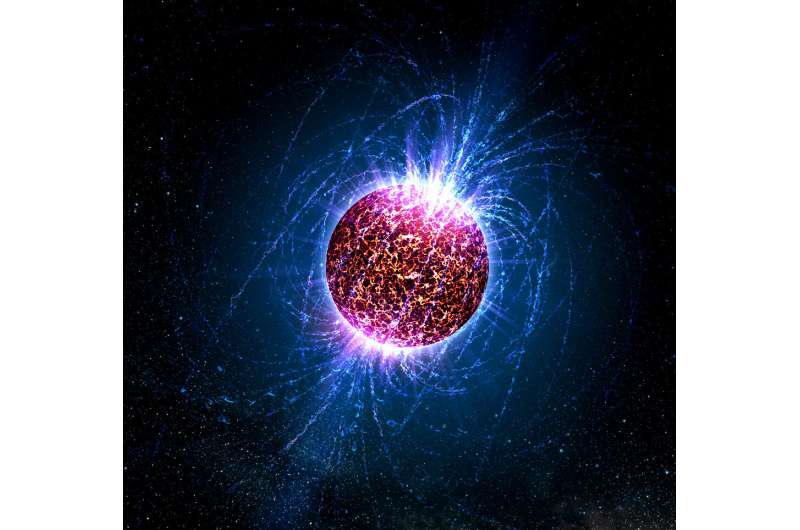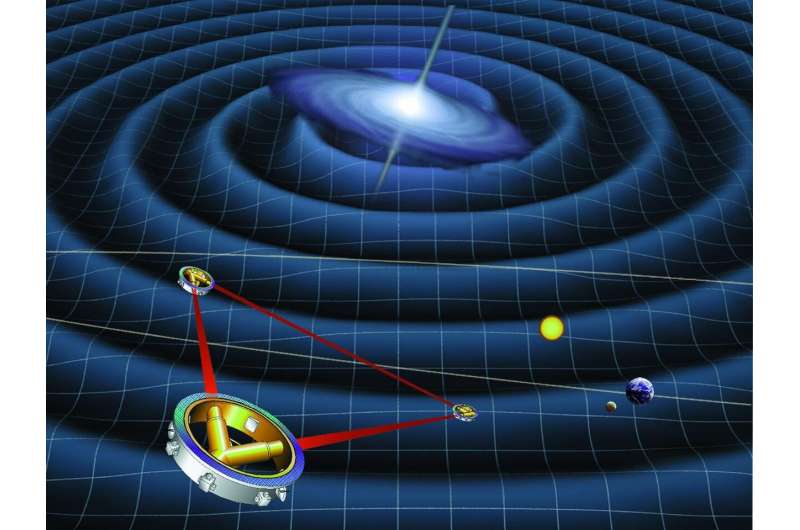Future space detector LISA could reveal the secret life and death of stars

A team of astrophysicists led by Ph.D. student Mike Lau, from the ARC Centre of Excellence in Gravitational Wave Discovery (OzGrav), recently predicted that gravitational waves of double neutron stars may be detected by the future space satellite LISA. The results were presented at the 14th annual Australian National Institute for Theoretical Astrophysics (ANITA) science workshop 2020. These measurements may help decipher the life and death of stars.
Lau, first author of the paper, compares his team to astro-paleontologists: "Like learning about a dinosaur from its fossil, we piece together the life of a binary star from their double neutron star fossils."
A neutron star is the remaining 'corpse' of a huge star after the supernova explosion that occurs at the end of its life. A double neutron star, a system of two neutron stars orbiting each other, produces periodic disturbances in the surrounding space-time, much like ripples spreading on a pond surface. These 'ripples' are called gravitational waves, and made headlines when the LIGO/Virgo Collaboration detected them for the first time in 2015. These gravitational waves formed when a pair of black holes spiraled too close together and merged.
However, scientists still haven't found a way to measure the gravitational waves given off when two neutron stars or black holes are still far apart in their orbit. These weaker waves hold valuable information about the lives of stars and could reveal the existence of entirely new object populations in our Galaxy.

The recent study shows that the Laser Interferometer Space Antenna (LISA) could potentially detect these gravitational waves from double neutron stars. LISA is a space-borne gravitational-wave detector that is scheduled for launch in 2034, as part of a mission led by the European Space Agency. It's made of three satellites linked by laser beams, forming a triangle that will orbit the Sun. Passing gravitational waves will stretch and squeeze the 40 million-kilometer laser arms of this triangle. The highly sensitive detector will pick up the slowly-oscillating waves—these are currently undetectable by LIGO and Virgo.
Using computer simulations to model a population of double neutron stars, the team predicts that in four years of operation, LISA will have measured the gravitational waves emitted by dozens of double neutron stars as they orbit each other. Their results were published in the Monthly Notices of the Royal Astronomical Society.
A supernova explosion kicks the neutron star it forms and makes the initial circular orbit oval-shaped. Usually, gravitational wave emission rounds off the orbit—that is the case for double neutron stars detected by LIGO and Virgo. But LISA will be able to detect double neutron stars when they're still far apart, so it may be possible to catch a glimpse of the oval orbit.
How oval the orbit is, described as the eccentricity of the orbit, can tell astronomers a lot about what the two stars looked like before they became double neutron stars. For example, their separation and how strongly they were 'kicked' by the supernova.
The understanding of binary stars—stars that are born as a pair—is plagued with many uncertainties. Scientists hope that by the 2030s, LISA's detection of double neutron stars will shed some light on their secret lives.
More information: Mike Y M Lau et al. Detecting double neutron stars with LISA, Monthly Notices of the Royal Astronomical Society (2020). DOI: 10.1093/mnras/staa002
Journal information: Monthly Notices of the Royal Astronomical Society





















